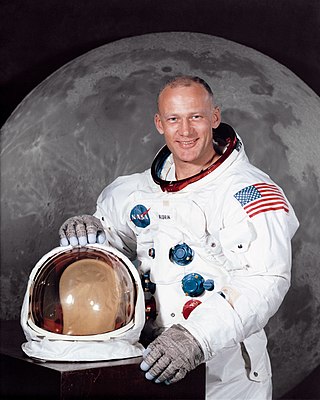
Buzz Aldrin is an American former astronaut, engineer and fighter pilot. He made three spacewalks as pilot of the 1966 Gemini 12 mission, and was the Lunar Module Eagle pilot on the 1969 Apollo 11 mission. He was the second person to walk on the Moon after mission commander Neil Armstrong.

Clifford Parker Robertson III was an American actor whose career in film and television spanned over six decades. Robertson portrayed a young John F. Kennedy in the 1963 film PT 109, and won the 1968 Academy Award for Best Actor for his role in the film Charly.
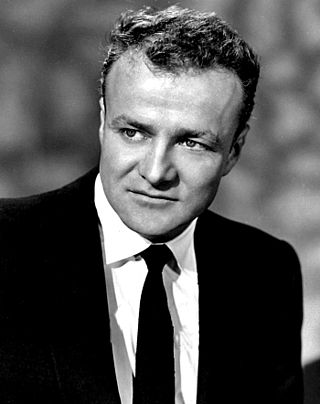
Robert Alba Keith, known professionally as Brian Keith, was an American film, television, and stage actor who in his six-decade career gained recognition for his work in films such as the Disney family film The Parent Trap (1961); Johnny Shiloh (1963); the comedy The Russians Are Coming, the Russians Are Coming (1966); and the adventure saga The Wind and the Lion (1975), in which he portrayed President Theodore Roosevelt.
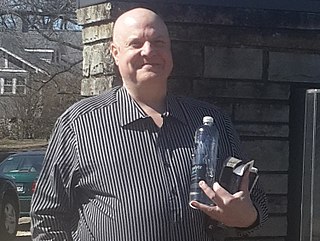
Bart Winfield Sibrel is an American conspiracy theorist who has written, produced, and directed films arguing that the Apollo Moon landings between 1969 and 1972 were staged by NASA under the control of the CIA. He has created four independent films promoting the ideas, with the first having been the film A Funny Thing Happened on the Way to the Moon (2001).

Too Late the Hero is a 1970 American war film directed by Robert Aldrich and starring Michael Caine, Cliff Robertson, Ian Bannen and Harry Andrews.
The International Space Development Conference (ISDC) is the annual conference of the National Space Society (NSS). Now in its 41st year, these conferences connect the general public and the NSS membership with leaders of contemporary space efforts. The ISDC provides a nexus for industry, government, scientists, advocates, and the public to meet and discuss the latest issues in space technology, science, policy, commerce, medicine, exploration, settlement and much more. Winners of the annual NASA space settlement Contest annually attend the conference, with several interesting activities and programs. With National Space Society's major goal being to accelerate the process of space exploration and development they also foster astronautics for students by encouraging them and getting them involved.

Morris Ankrum was an American radio, television, and film character actor.
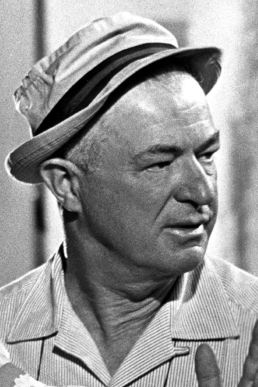
Naftuli Hertz "Nathan" Juran was an Austrian-born film art director, and later film and television director. As an art director, he won the Oscar for Best Art Direction in 1942 for How Green Was My Valley, along with Richard Day and Thomas Little. His work on The Razor's Edge in 1946 also received an Academy nomination. In the 1950s, he began to direct, and was known for science fiction and fantasy films such as Attack of the 50 Foot Woman. He was also the brother of quality guru Joseph M. Juran.

When Worlds Collide is a 1951 American science fiction disaster film released by Paramount Pictures. It was produced by George Pal, directed by Rudolph Maté, and stars Richard Derr, Barbara Rush, Peter Hansen, and John Hoyt. The film is based on the 1933 science fiction novel of the same name, co-written by Edwin Balmer and Philip Wylie.

Apollo 11 was the first human spaceflight to land on the Moon. The 1969 mission's wide effect on popular culture has resulted in numerous portrayals of Apollo 11 and its crew, Neil Armstrong, Buzz Aldrin, and Michael Collins.

Island of Lost Women is a 1959 American independently made black-and-white castaways melodrama film, produced by George C. Bertholon, Albert J. Cohen, and Alan Ladd, that was directed by Frank Tuttle and released by Warner Bros. Pictures. The film stars Jeff Richards, Venetia Stevenson, John Smith, Alan Napier, Diane Jergens, and June Blair. The film's storyline borrows details from Shakespeare's The Tempest and more contemporaneously the 1956 science fiction film Forbidden Planet.
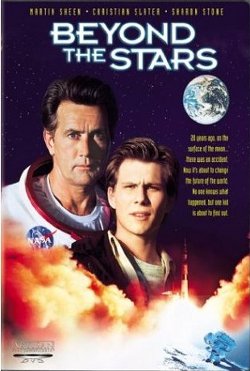
Beyond the Stars is a 1989 American science-fiction drama film written and directed by David Saperstein and starred Martin Sheen, Christian Slater, Sharon Stone, Olivia d'Abo, and F. Murray Abraham. The film was originally titled Personal Choice. It was never released in theaters.

The Girl Most Likely is a 1958 American musical comedy film about a young woman who becomes engaged to three men at the same time. The film, a remake of Tom, Dick and Harry (1941), was directed by Mitchell Leisen, and stars Jane Powell, Cliff Robertson, and Keith Andes. The choreography is by Gower Champion.
Below is a list of Grand Marshals of the Rose Parade. This is an honorary position selected by the president of the Pasadena Tournament of Roses Association. Many marshals are picked for a relationship to the theme that is also picked by the president. Traditionally, the Grand Marshal of the Rose Parade also participates in the coin toss during the Rose Bowl Game.
Rocket Science is a miniseries first released in 2002-2003, chronicling the major events in the American-Soviet space race, starting from the first hypersonic rocket planes through the development of human space flight, culminating with the mission by mission history of Projects Mercury, Gemini and Apollo. The series features interviews with X-1 and X-15 pilots Chuck Yeager, Scott Crossfield and Pete Knight, astronauts Gordon Cooper, Wally Schirra, Scott Carpenter, Gene Cernan, Frank Borman, James Lovell, Buzz Aldrin and Alan Bean, flight controllers Gene Kranz, Christopher Kraft, John Hodge and Sy Liebergot, engineers Günter Wendt, Max Faget, John Houbolt, Bob Gore, Robert Sieck and Richard Dunne, authors Arthur C. Clarke, Andrew Chaikin, Robert Godwin, Spider Robinson and Robert J. Sawyer, historians Paul Fjeld and Professor John Lienhart, Dr Raymond Puffer and Dr James Young, Manhattan Project physicist Hans Bethe, head of the Lovelace Clinic Dr. Donald E. Kilgore, Dr David Simons of Holloman AFB, Colonel Joe Kittinger, and broadcaster Walter Cronkite, among others. While focusing mainly on the American side of the race, the series also covered major Soviet achievements through every key phase of the 1950s and 1960s Space Race.
Apollo 11 is a television docudrama film which aired on November 17, 1996 on The Family Channel. It was nominated for a Primetime Emmy.

The Big Guy is a 1939 American drama crime film directed by Arthur Lubin starring Victor McLaglen and Jackie Cooper.

Frank Dirceu Braun (Niterói) is a Brazilian and American journalist, author and entrepreneur. He is a writer and producer, with over 25 years of experience in both print and broadcast journalism. Braun has worked as an Associate Producer for 60 Minutes, and as an Investigative Producer for the CBS affiliated stations. He has covered the space programs of Brazil, the United States, and China for over a decade. Braun has also written for United Press International, CBS. News, Space News, and Business Week magazine.
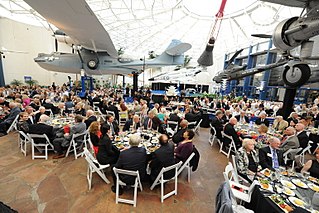
The International Air & Space Hall of Fame is an honor roll of people, groups, organizations, or things that have contributed significantly to the advancement of aerospace flight and technology, sponsored by the San Diego Air & Space Museum. Since its founding in 1963, over 200 individuals have been inducted into the Hall, with new additions inaugurated at an annual gala.

Lunar Module Eagle (LM-5) is the spacecraft that served as the crewed lunar lander of Apollo 11, which was the first mission to land humans on the Moon. It was named after the bald eagle, which was featured prominently on the mission insignia. It flew from Earth to lunar orbit on the command module Columbia, and then was flown to the Moon on July 20, 1969, by astronaut Neil Armstrong with navigational assistance from Buzz Aldrin. Eagle's landing created Tranquility Base, named by Armstrong and Aldrin and first announced upon the module's touchdown.
















